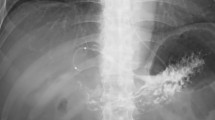A 65-year-old Japanese man underwent radiofrequency ablation (RFA) therapy of a hepatocellular carcinoma. Hemobilia from the intrahepatic bile ducts adjacent to the tumor developed on the fifth day after the RFA therapy. Ultrasonograms and computed tomograms showed swelling of the gallbladder, which was filled with a clot, suggesting the diagnosis of hemocholecyst. The hemobilia resolved with conservative therapy, but a cholecystectomy was performed to manage postprandial abdominal pain. The resected gallbladder was filled with a clot, but injury or ulceration of the gallbladder was absent, suggesting that the hemocholecyst developed secondary to the hemobilia. Secondary hemocholecyst is a rare complication of RFA therapy. The number of cases of secondary hemocholecyst is likely to increase as hepatocentestic therapy becomes more common. Cholecystectomy is indicated for hemocholecyst because spontaneous liquefication and drainage of a clot in the gallbladder usually does not occur.
Similar content being viewed by others
Author information
Authors and Affiliations
Additional information
Received: December 10, 2001 / Accepted: March 8, 2002
Reprint requests to: T. Yamamoto
Rights and permissions
About this article
Cite this article
Yamamoto, T., Kubo, S., Hirohashi, K. et al. Secondary hemocholecyst after radiofrequency ablation therapy for hepatocellular carcinoma. J Gastroenterol 38, 399–403 (2003). https://doi.org/10.1007/s005350300071
Issue Date:
DOI: https://doi.org/10.1007/s005350300071




